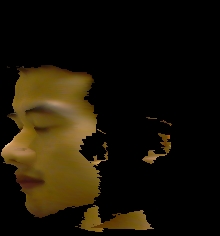Real-Time Image Mosaicing
By stitching together multiple images taken from different viewpoints or
camera orientations, Image Mosaicing technique enables us to experience
a photorealistic virtual environment without really having the 3D model
of the scene.
I implemented an Image Mosaicing system based on Richard
Szeliski's planar perspective motion models. Two Images can be initially
stitched together by user interaction, and then automatically stitched
in real time. For speed purpose, I exploited hardware-accelerated texture
mapping to resample the images and OpenGL Mipmaps to implement hierarchical
matching. With this system, I generated the following two 8-image mosaics
of University
Center Mural:
The sixteen images in the first and fifth rows are taken inside University
Center. The mosaics following them are generated pair wise. The final
mosaics in the fourth and eighth rows are of size 827x311 and 1008x488
respectively. It takes about 1 second to generate each of them.
Reference:
R. Szeliski and H.-Y. Shum, Creating full view panoramic image mosaics
and Environment Maps, Computer
Graphics (SIGGRAPH'97), pages
251-258, August 1997.
2.5D Image Warping
The geometry of the real-world is exceedingly complex. Light's interaction
with the geometry is hard to simulate. However, images taken from the real-world
capture the result of this simulation. Given an image with the camera calibration,
new images from novel viewpoints are able to be generated by image
warping.
I implemented an Image Warping system based on Leonard
McMillan's warping equation with visibility ordering algorithm. I used
Vivid Scanner to produce a 3D model of my face, ( too timid to open my
eyes ) and used Paul's
codes to convert it into ( R,G,B,Delta ) format with camera information
given. I generated 8 images from new viewpoints, shown as follows:
The the image in the middle is taken by Vivid Scanner. The images around
it are synthesized by image warping.
Reference:
Leonard
McMillan's Ph.D. Thesis.
Image Morphing
Subdivision Surface
Recursive Ray Tracing
The following picture is rendered by my simple recursive ray tracer that
includes shadow casting, specular reflection, and refractive transparency.

Radiosity Method
return to Li Zhang's homepage















































